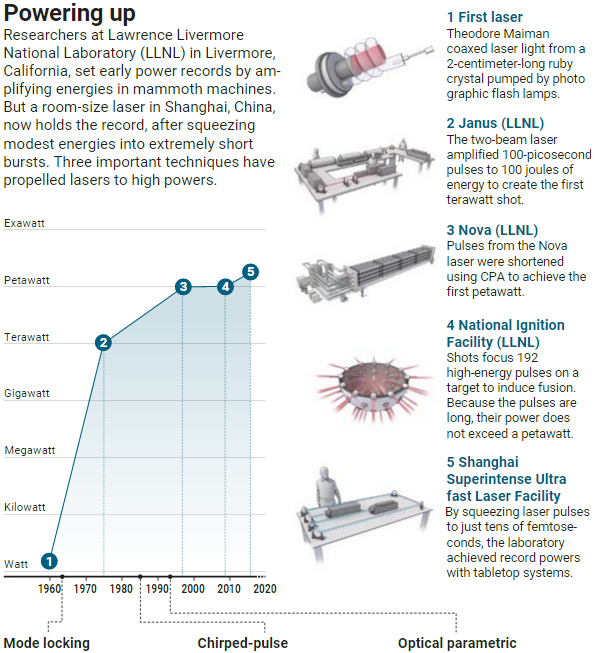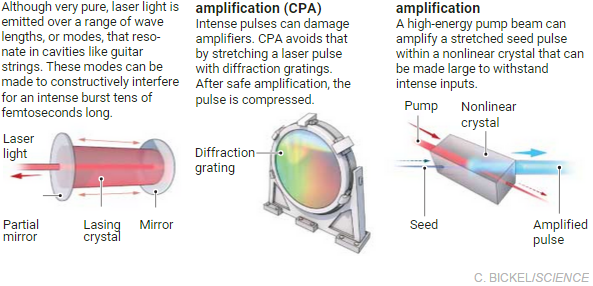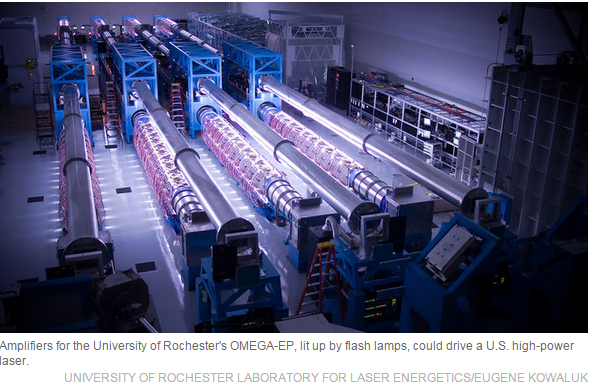By Edwin CartlidgeJan. 24, 2018 , 9:00 AM
Inside a cramped laboratory in Shanghai, China, physicist Ruxin Li and colleagues are breaking records with the most powerful pulses of light the world has ever seen. At the heart of their laser, called the Shanghai Superintense Ultrafast Laser Facility (SULF), is a single cylinder of titanium-doped sapphire about the width of a Frisbee. After kindling light in the crystal and shunting it through a system of lenses and mirrors, the SULF distills it into pulses of mind-boggling power. In 2016, it achieved an unprecedented 5.3 million billion watts, or petawatts (PW). The lights in Shanghai do not dim each time the laser fires, however. Although the pulses are extraordinarily powerful, they are also infinitesimally brief, lasting less than a trillionth of a second. The researchers are now upgrading their laser and hope to beat their own record by the end of this year with a 10-PW shot, which would pack more than 1000 times the power of all the world's electrical grids combined.
The group's ambitions don't end there. This year, Li and colleagues intend to start building a 100-PW laser known as the Station of Extreme Light (SEL). By 2023, it could be flinging pulses into a chamber 20 meters underground, subjecting targets to extremes of temperature and pressure not normally found on Earth, a boon to astrophysicists and materials scientists alike. The laser could also power demonstrations of a new way to accelerate particles for use in medicine and high-energy physics. But most alluring, Li says, would be showing that light could tear electrons and their antimatter counterparts, positrons, from empty space—a phenomenon known as "breaking the vacuum." It would be a striking illustration that matter and energy are interchangeable, as Albert Einstein's famous E=mc2 equation states. Although nuclear weapons attest to the conversion of matter into immense amounts of heat and light, doing the reverse is not so easy. But Li says the SEL is up to the task. "That would be very exciting," he says. "It would mean you could generate something from nothing."
The Chinese group is "definitely leading the way" to 100 PW, says Philip Bucksbaum, an atomic physicist at Stanford University in Palo Alto, California. But there is plenty of competition. In the next few years, 10-PW devices should switch on in Romania and the Czech Republic as part of Europe's Extreme Light Infrastructure, although the project recently put off its goal of building a 100-PW-scale device. Physicists in Russia have drawn up a design for a 180-PW laser known as the Exawatt Center for Extreme Light Studies (XCELS), while Japanese researchers have put forward proposals for a 30-PW device.
Largely missing from the fray are U.S. scientists, who have fallen behind in the race to high powers, according to a study published last month by a National Academies of Sciences, Engineering, and Medicine group that was chaired by Bucksbaum. The study calls on the Department of Energy to plan for at least one high-power laser facility, and that gives hope to researchers at the University of Rochester in New York, who are developing plans for a 75-PW laser, the Optical Parametric Amplifier Line (OPAL). It would take advantage of beamlines at OMEGA-EP, one of the country's most powerful lasers. "The [Academies] report is encouraging," says Jonathan Zuegel, who heads the OPAL.
Invented in 1960, lasers use an external "pump," such as a flash lamp, to excite electrons within the atoms of a lasing material—usually a gas, crystal, or semiconductor. When one of these excited electrons falls back to its original state it emits a photon, which in turn stimulates another electron to emit a photon, and so on. Unlike the spreading beams of a flashlight, the photons in a laser emerge in a tightly packed stream at specific wavelengths.
Because power equals energy divided by time, there are basically two ways to maximize it: Either boost the energy of your laser, or shorten the duration of its pulses. In the 1970s, researchers at Lawrence Livermore National Laboratory (LLNL) in California focused on the former, boosting laser energy by routing beams through additional lasing crystals made of glass doped with neodymium. Beams above a certain intensity, however, can damage the amplifiers. To avoid this, LLNL had to make the amplifiers ever larger, many tens of centimeters in diameter. But in 1983, Gerard Mourou, now at the école Polytechnique near Paris, and his colleagues made a breakthrough. He realized that a short laser pulse could be stretched in time—thereby making it less intense—by a diffraction grating that spreads the pulse into its component colors. After being safely amplified to higher energies, the light could be recompressed with a second grating. The end result: a more powerful pulse and an intact amplifier.


This "chirped-pulse amplification" has become a staple of high-power lasers. In 1996, it enabled LLNL researchers to generate the world's first petawatt pulse with the Nova laser. Since then, LLNL has pushed to higher energies in pursuit of laser-driven fusion. The lab's National Ignition Facility (NIF) creates pulses with a mammoth 1.8 megajoules of energy in an effort to heat tiny capsules of hydrogen to fusion temperatures. However, those pulses are comparatively long and they still generate only about 1 PW of power.
To get to higher powers, scientists have turned to the time domain: packing the energy of a pulse into ever-shorter durations. One approach is to amplify the light in titanium-doped sapphire crystals, which produce light with a large spread of frequencies. In a mirrored laser chamber, those pulses bounce back and forth, and the individual frequency components can be made to cancel each other out over most of their pulse length, while reinforcing each other in a fleeting pulse just a few tens of femtoseconds long. Pump those pulses with a few hundred joules of energy and you get 10 PW of peak power. That's how the SULF and other sapphire-based lasers can break power records with equipment that fits in a large room and costs just tens of millions of dollars, whereas NIF costs $3.5 billion and needs a building 10 stories high that covers the area of three U.S. football fields.
Raising pulse power by another order of magnitude, from 10 PW to 100 PW, will require more wizardry. One approach is to boost the energy of the pulse from hundreds to thousands of joules. But titanium-sapphire lasers struggle to achieve those energies because the big crystals needed for damage-free amplification tend to lase at right angles to the beam—thereby sapping energy from the pulses. So scientists at the SEL, XCELS, and OPAL are pinning their hopes on what are known as optical parametric amplifiers. These take a pulse stretched out by an optical grating and send it into an artificial "nonlinear" crystal, in which the energy of a second, "pump" beam can be channeled into the pulse. Recompressing the resulting high-energy pulse raises its power.
To approach 100 PW, one option is to combine several such pulses—four 30-PW pulses in the case of the SEL and a dozen 15-PW pulses at the XCELS. But precisely overlapping pulses just tens of femtoseconds long will be "very, very difficult," says LLNL laser physicist Constantin Haefner. They could be thrown off course by even the smallest vibration or change in temperature, he argues. The OPAL, in contrast, will attempt to generate 75 PW using a single beam.
Mourou envisions a different route to 100 PW: adding a second round of pulse compression. He proposes using thin plastic films to broaden the spectrum of 10-PW laser pulses, then squeezing the pulses to as little as a couple of femtoseconds to boost their power to about 100 PW.
Once the laser builders summon the power, another challenge will loom: bringing the beams to a singularly tight focus. Many scientists care more about intensity—the power per unit area—than the total number of petawatts. Achieve a sharper focus, and the intensity goes up. If a 100-PW pulse can be focused to a spot measuring just 3 micrometers across, as Li is planning for the SEL, the intensity in that tiny area will be an astonishing 1024 watts per square centimeter (W/cm2)—some 25 orders of magnitude, or 10 trillion trillion times, more intense than the sunlight striking Earth.
Those intensities will open the possibility of breaking the vacuum. According to the theory of quantum electrodynamics (QED), which describes how electromagnetic fields interact with matter, the vacuum is not as empty as classical physics would have us believe. Over extremely short time scales, pairs of electrons and positrons, their antimatter counterparts, flicker into existence, born of quantum mechanical uncertainty. Because of their mutual attraction, they annihilate each another almost as soon as they form.
But a very intense laser could, in principle, separate the particles before they collide. Like any electromagnetic wave, a laser beam contains an electric field that whips back and forth. As the beam's intensity rises, so, too, does the strength of its electric field. At intensities around 1024 W/cm2, the field would be strong enough to start to break the mutual attraction between some of the electron-positron pairs, says Alexander Sergeev, former director of the Russian Academy of Sciences's (RAS's) Institute of Applied Physics (IAP) in Nizhny Novgorod and now president of RAS. The laser field would then shake the particles, causing them to emit electromagnetic waves—in this case, gamma rays. The gamma rays would, in turn, generate new electron-positron pairs, and so on, resulting in an avalanche of particles and radiation that could be detected. "This will be completely new physics," Sergeev says. He adds that the gamma ray photons would be energetic enough to push atomic nuclei into excited states, ushering in a new branch of physics known as "nuclear photonics"—the use of intense light to control nuclear processes.

One way to break the vacuum would be to simply focus a single laser beam onto an empty spot inside a vacuum chamber. But colliding two beams makes it easier, because this jacks up the momentum needed to generate the mass for electrons and positrons. The SEL would collide photons indirectly. First, the pulses would eject electrons from a helium gas target. Other photons from the laser beam would ricochet off the electrons and be boosted into high-energy gamma rays. Some of these in turn would collide with optical photons from the beam.
Documenting these head-on photon collisions would itself be a major scientific achievement. Whereas classical physics insists that two light beams will pass right through each other untouched, some of the earliest predictions of QED stipulate that converging photons occasionally scatter off one another. "The predictions go back to the early 1930s," says Tom Heinzl, a theoretical physicist at Plymouth University in the United Kingdom. "It would be good if we could confirm them experimentally."
Besides making lasers more powerful, researchers also want to make them shoot faster. The flash lamps that pump the initial energy into many lasers must be cooled for minutes or hours between shots, making it hard to carry out research that relies on plenty of data, such as investigating whether, very occasionally, photons transform into particles of the mysterious dark matter thought to make up much of the universe's mass. "Chances are you would need a lot of shots to see that," says Manuel Hegelich, a physicist at the University of Texas in Austin.
A higher repetition rate is also key to using a high-power laser to drive beams of particles. In one scheme, an intense beam would transform a metal target into a plasma, liberating electrons that, in turn, would eject protons from nuclei on the metal's surface. Doctors could use those proton pulses to destroy cancers—and a higher firing rate would make it easier to administer the treatment in small, individual doses.
Physicists, for their part, dream of particle accelerators powered by rapid-fire laser pulses. When an intense laser pulse strikes a plasma of electrons and positive ions, it shoves the lighter electrons forward, separating the charges and creating a secondary electric field that pulls the ions along behind the light like water in the wake of a speedboat. This "laser wakefield acceleration" can accelerate charged particles to high energies in the space of a millimeter or two, compared with many meters for conventional accelerators. Electrons thus accelerated could be wiggled by magnets to create a so-called free-electron laser (FEL), which generates exceptionally bright and brief flashes of x-rays that can illuminate short-lived chemical and biological phenomena. A laser-powered FEL could be far more compact and cheaper than those powered by conventional accelerators.
In the long term, electrons accelerated by high-repetition PW pulses could slash the cost of particle physicists' dream machine: a 30-kilometer-long electron-positron collider that would be a successor to the Large Hadron Collider at CERN, the European particle physics laboratory near Geneva, Switzerland. A device based on a 100-PW laser could be at least 10 times shorter and cheaper than the roughly $10 billion machine now envisaged, says Stuart Mangles, a plasma physicist at Imperial College London.
Both the linear collider and rapid-fire FELs would need thousands, if not millions, of shots per second, well beyond current technology. One possibility, being investigated by Mourou and colleagues, is to try to combine the output of thousands of quick-firing fiber amplifiers, which don't need to be pumped with flash tubes. Another option is to replace the flash tubes with diode lasers, which are expensive, but could get cheaper with mass production.
For the moment, however, Li's group in China and its U.S. and Russian counterparts are concentrating on power. Efim Khazanov, a laser physicist at IAP, says the XCELS could be up and running by about 2026—assuming the government agrees to the cost: roughly 12 billion rubles (about $200 million). The OPAL, meanwhile, would be a relative bargain at between $50 million and $100 million, Zuegel says.
But the first laser to rip open the vacuum is likely to be the SEL, in China. An international committee of scientists last July described the laser's conceptual design as "unambiguous and convincing," and Li hopes to get government approval for funding—about $100 million—early this year. Li says other countries need not feel left in the shadows as the world's most powerful laser turns on, because the SEL will operate as an international user facility. Zuegel says he doesn't "like being second," but acknowledges that the Chinese group is in a strong position. "China has plenty of bucks," he says. "And it has a lot of really smart people. It is still catching up on a lot of the technology, but it's catching up fast."
Posted in: Asia/PacificSpaceTechnology
doi:10.1126/science.aat0939
Home | About SIOM | Newsroom | International | Admissions | Publications | Contact
@ Shanghai Institute of Optics and Fine Mechanics Tel:02169918000 沪ICP备05015387号-1 Technical support:Qingyun Software